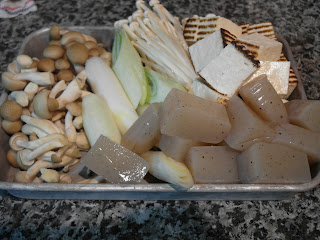I love Autumn. I like the drop in temperature. I like taking out my jackets and scarves from the back of the closet. And I like eating soups and stews. Food blogs go soup crazy around this time of year and it makes my belly warm just sifting through all the recipes. There is one dish I have always wanted to try in Japan. More of a stew than a soup, nabe (nah-bay) is a Japanese cold weather staple. Though it is incredibly simple to make, it is very hearty and filling. This is after all, the dish that sumo wrestlers eat when they want to gain weight.
This version I made is probably the simplest type of nabe. I was feeling sick and nabe sounded perfect. I didn't know how to make it exactly, but I knew what I wanted to go in it, so I bought my ingredients and kind of winged it. It turned out great so here's my overly simple nabe recipe:
Make a simple dashi with water and dried kombu seaweed. You can also use plain water or a low-sodium chicken broth.
Prepare bite sized pieces of veggies you like. Mushrooms, leeks, tofu and no calorie konnyaku...
...cabbage, bean sprouts, chinese chives and carrots. Nabe is so popular in the winter that grocery stores stock prepared nabe sets like this one above with pre-cut veggies and instant broth.
Dice up some meat. My two favorites shown here - chicken and pork
Once your dashi comes to a boil, remove the seaweed and turn down to simmer. Then start adding your ingredients being sure to add the meats and tofu first, since they take longer to cook. When you're sure the meats are cooked, ladle the contents into small bowls with a little bit of broth and start eating. Usually, nabe is cooked in a clay pot right at the table over a portable gas burner. I don't have one of those and just used my dutch oven on the stove. You miss out on some of the communal fun of family style hot pot, but it tastes all the same. You can add different kinds of sauces to this simple dish, but my favorite is definitely this yuzu ponzu sauce. It's tart, vinegary and delicious. Of late, kimchi has become a popular pairing.
My favorite part of nabe is how you finish off the pot. Once most of the ingredients have been eaten, add udon noodles to the leftover broth and you have a super flavorful udon soup! Japanese families never waste a single grain of rice, so this is a great way to put that leftover broth to use.






